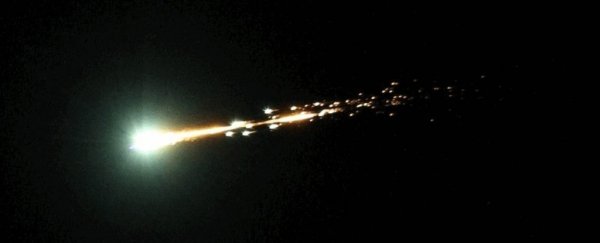On 11 March 2022, at around 9:20 pm UTC, a small asteroid entered Earth's atmosphere.
This is not unusual. Space rocks enter Earth's atmosphere all the time. What makes this asteroid so amazing is that an astronomer spotted it before it made its rendezvous with atmospheric entry. It's named 2022 EB5, and it's only the fifth asteroid we've ever managed to spot prior to impact.
The object, thought to measure around two meters across (6.5 ft), was spotted by astronomer Krisztián Sárneczky of Konkoly Observatory's Piszkéstető Station in Hungary, at 7:24 pm UTC.
5th Earth impactor from Piszkéstető Obs: 2022 EB5
— Stefan Kurti (@KurtiStefan) March 12, 2022
Yesterday at 19:24 UT an unknown moving objects of 17 mag was found by K. Sárneczky on images from 0.6-m Schmidt telescope. Acquired data 30 min later showed that it was going to collide with Earth in 2 hours time. pic.twitter.com/NdLUcF1MnM
It entered Earth's atmosphere two hours later, at 9:22 pm UTC, over the Arctic Ocean just South-West of Norway's Jan Mayen island, at an entry speed of around 18 kilometers per second (11 mps).
Not long after that, infrasound instruments in Greenland and Norway picked up an explosion, likely from the object shattering in the sky before falling into the ocean.
According to those detections, the blast had a yield of about 2,000 tons of TNT.
Infrasound detection from 2022 EB5 impact off the coast of Iceland at I37NO between 2223-2227 UTC. Below is I18DK infrasound data in Greenland. Arrival near 2340 UTC. From this data yield is approximately 2-3 kT TNT. At 15 km/s, this is roughly 3-4 m diameter. @WesternU #2002EB5 pic.twitter.com/FYI9jn7zCb
— Peter Brown (@pgbrown) March 12, 2022
The previous four asteroids detected prior to impact were 2008 TC3, which was around 4 meters across and exploded with the energy of up to 2,100 tons of TNT; 2014 AA, at 3 meters and up to 1,000 tons of TNT; 2018 LA, at 3 meters and 400 tons of TNT; and 2019 MO at 6 meters and 6,000 tons of TNT.
Most objects of this type will explode as they fall through Earth's atmosphere, turning into what we call a bolide. Scientists think this occurs when air enters the object's body through small fractures in the meteor, causing a build-up of pressure as it flies through the atmosphere at high speed.
Fragments of the asteroid may fall to Earth, but anything left of 2022 EB5 after burning probably fell into the ocean. This, too, is normal: most of Earth's surface is covered by water, so it stands to reason that most space rocks will end up there.
Impact! When 2022 EB5 struck the Earth north of Iceland this morning, it became the 5th asteroid to be discovered prior to impacting Earth. pic.twitter.com/kYsQ40uuFq
— Tony Dunn (@tony873004) March 12, 2022
However, the discovery of 2022 EB5 is amazing for another reason.
The increasing number of asteroids detected prior to impact, as well as their decreasing size, bodes well for our hazardous asteroid detection capabilities. 2022 EB5 was never large enough to be considered hazardous, but if we can detect small, non-hazardous objects, that suggests our detection capabilities are getting better.
People in Norway or northern Iceland may have seen a brief flash light up their skies for a few seconds as the burning bolide streaked across the sky. If you were one of them, you can report your sighting to the International Meteor Organization here.
